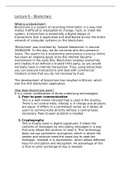College aantekeningen
Class notes on Blockchain and Cryptocurrency (R_GRET)
- Instelling
- Vrije Universiteit Amsterdam (VU)
Notes explaining in depth how a blockchain works, including notes on peer-to-peer communication, cryptography, and hashing. How are blockchains created? Why are they used? What legal impact do they have? Includes possible applications of blockchain and the advantages and disadvantages.
[Meer zien]




